As drug manufacturing becomes larger scale and more complex, more and more pharmaceutical companies are partnering with contract manufacturing and contract development organizations (CMOs and CDMOs) for the ownership and management of their production efforts.
Large drug companies are increasingly using contract partners strategically to fill capacity and expertise gaps to produce their branded drugs. Tapemark has experience with drug owners seeking longer-term contract and development partners because we have the development and manufacturing expertise with operational know-how to accelerate the drug’s speed to market.
In this article, you’ll find details about our blending, coating, serialization, and shipping capabilities. Are you a pharmaceutical company interested in starting a project with us? Let’s talk.
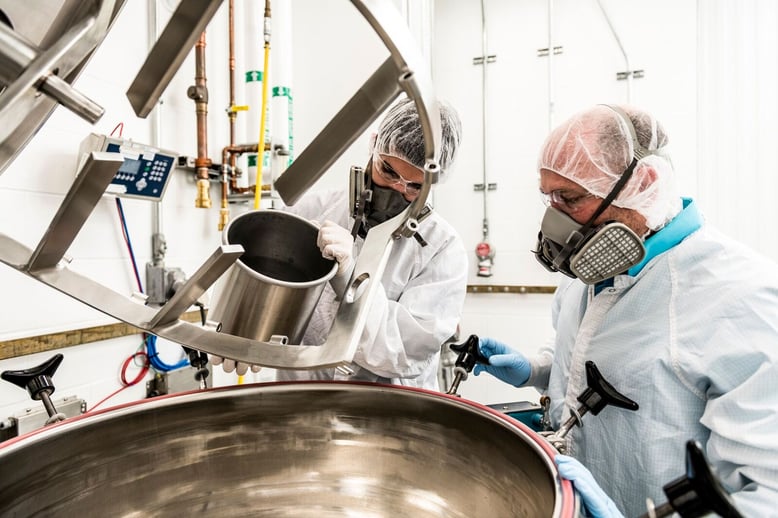
Having a strong manufacturing partner like Tapemark will better manage the costs and risks of development, quality control, and regulatory compliance more effectively.
1. Drug Blending
/tapemark-blending.jpg?width=300&name=tapemark-blending.jpg) For drug blending, we begin with an already developed formulation. Of course, if the formulation has yet to be developed, we at Tapemark have the commercial equipment and in-house expertise to develop a formulation for the client. In this article, we’re looking at the drug manufacturing process, which presupposes an existing formulation.
For drug blending, we begin with an already developed formulation. Of course, if the formulation has yet to be developed, we at Tapemark have the commercial equipment and in-house expertise to develop a formulation for the client. In this article, we’re looking at the drug manufacturing process, which presupposes an existing formulation.
Here at Tapemark, our mixing and blending capabilities are made possible by world-class equipment and facilities. With a wealth of experience and expertise with all types of materials and compound properties, we work tirelessly to develop an effective, product-specific blending process to optimize the blend and drug performance.
Mixture Stability
In the blending process, balance is everything. One must develop a stable and consistent mixture that can exist with the drug without altering or damaging the drug.
The first step?
We determine the batch size, select the appropriate blender, and calibrate all necessary blending equipment. With these initial variables determined, it’s time to define the preliminary blending process and select vessels for pre-mixing.
What is a Blender in the Pharma Industry?
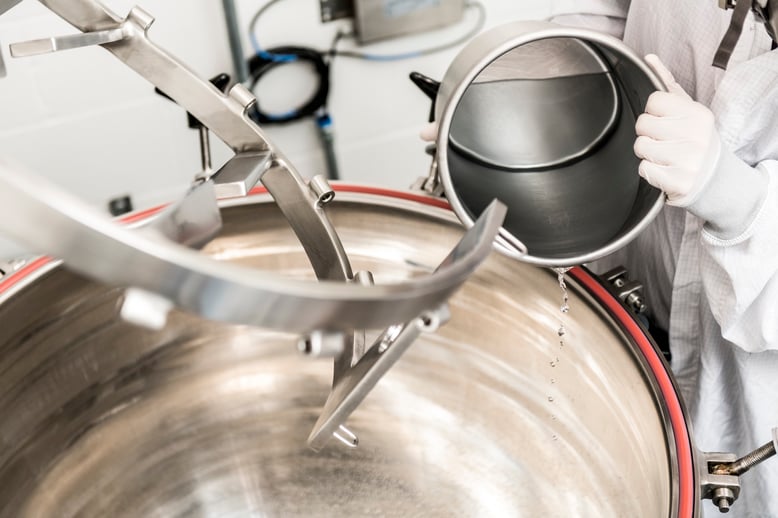
A blender in the pharma industry is a vessel used for mixing drugs with other materials. Depending on the drug and the delivery system, these other materials may be excipients, adhesives, or flavor additives.
Mixing vessels come in a wide range of sizes, able to accommodate varying levels of development and commercial production. In this video, watch as Tapemark’s Director of R&D, Marina Ruleva, provides a brief tour of our blending equipment.
Tapemark’s Blending Equipment
As you saw in the video, Marina introduces three of the mixing vessels we have here at Tapemark:
- 25-gallon mixing vessel
- 50-gallon mixing vessel
- 130-gallon mixing vessel
Our mixers are able to handle a wide range of viscosities, from water-like to very thick viscosities. Our mixing vessels are jacketed, allowing excellent control during heating and cooling.
Since most of our mixers are of the same basic mixing type and agitation methods, they are ideal for seamlessly scaling processes in a life-for-like manner. As we progress from a small, prototype batch to full-scale commercial manufacturing, the materials to be blended just need to be scaled up to match the blender size.
Having equipment setups like this allows us to pass cost savings onto our partners. We have seen, time and time again, how a small-scale batch can transfer seamlessly to a larger blender as long as it uses similar mixing and agitation methods.
Once we establish the blending parameters and develop an effective prototype, scaling production is a logical next step. Since quality is extremely important (second only to safety), we dedicate many resources during the prototyping phase, sampling our blends at each step of the process. We always finish with a final quality inspection. It’s one of the reasons why our approach is the best in the business.
Similar to our mixing services, Tapemark’s coating facilities have state-of-the-art equipment. In fact, you’ll find our investment in equipment and facilities to be consistent across all of our services. When new clients visit for a tour, they don’t find flashy, modernized office spaces, but they are consistently impressed with laboratories, clean rooms, and state-of-the-art equipment.
For us, investment in equipment and facilities is a key enabler in serving a wide range of clients with expertise and customization.
2. Drug Coating
Our commercial coating equipment is versatile, powerful, and capable of high volume throughput. It can meet a wide range of speeds, widths, and temperatures. Plus, it can accommodate both water and solvent-based formulations. This versatility enables us to match our clients' exact needs and varying formulations.
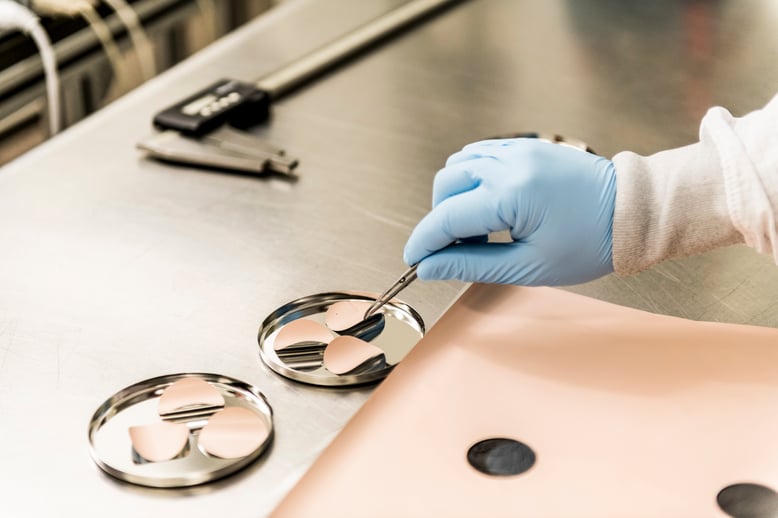
In order to create the most efficient process for our clients, we rely on a combination of experience, knowledge, and equipment. These things combined work to create the most efficient and effective process for our clients.
What follows is a sample of a high-level pharmaceutical coating process at Tapemark:
- Introduce the blend to establish parameters for the coating temperature, line speed, and thickness
- Meter the blend onto the polymer liner
- Throughout the process we use both inline and manual quality control verification
- The wet-blend liner goes into the state-of-the-art ovens
- Finished laminate is wound and prepared for the next step
Tapemark’s Commercial Coating Equipment & Capabilities
In this video, Marina Ruleva introduces the capabilities of our commercial coating equipment:
As you saw in the video, our pharmaceutical coating equipment has a wide range of temperature, width, and speed control.
- We have the ability to set temperatures anywhere from 100 degrees Fahrenheit to 350 degrees Fahrenheit.
- We can coat widths as narrow as three inches and as wide as 22 inches.
- We can run line speeds as slow as 0.8 feet per minute and as fast as 65 feet per minute.
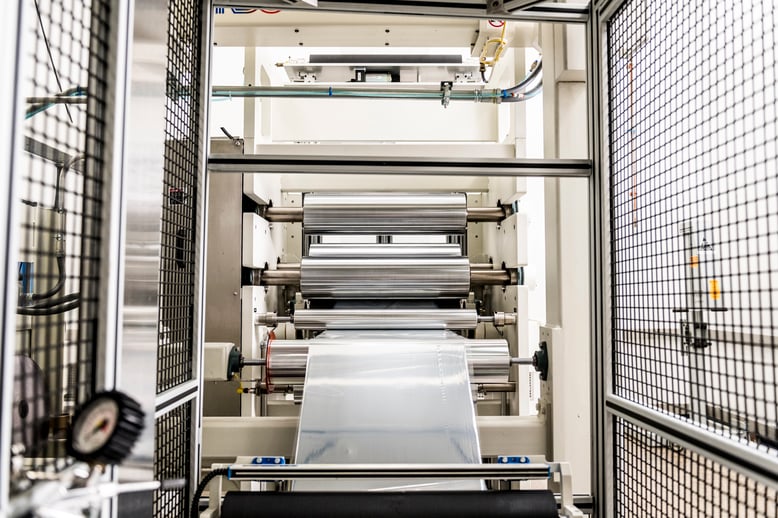 These coating capabilities provide us a competitive advantage in developing both solvent-based systems and water-based systems.
These coating capabilities provide us a competitive advantage in developing both solvent-based systems and water-based systems.
For example, when we coat water-based systems we use higher temperatures and lower speeds, and for our solvent-based systems we use lower temperatures and higher speeds. Without this equipment, we would not have these capabilities.
Types of Pharmaceutical Coating
Our traditional coating setup is with a comma head die. We use comma head die coating for our solvent-based systems, but in addition to that, we also have slot die coating capabilities which use slot die for water-based systems.
If you’re interested in an in-depth look at slot die and comma head coating, review this article where Tapemark’s Mike Rothaupt leads you through the advantages and disadvantages of these different types of coating.
Comma Head Coating vs Slot Die Coating
A comma head die offers intuitive operation for excellent control of the coating thickness. The comma head’s primary disadvantage is the blend faces environmental exposure during its time in the coating trough, and any variation in the release line or quality of the release coating will impact how it is sheared.
On the other hand, slot die coating involves a completely closed system, eliminating the opportunity for solvent loss or contamination. Additionally, the slot die meters the blend and allows for easy stop and start. The main disadvantage of the slot die is the difficulty involved in dialing in the process for precision.
3. Pharmaceutical Serialization
At Tapemark, our serialization capabilities are excellent and can meet the highest commercial quantities. With several serialization lines, our experience includes performing aggregation on multiple levels with multiple products. We follow HDA guidelines and GS1 standards for proper EPCIS formatting and label structures. We have met all DSCSA requirements and are confident in our ability to produce fully traceable products.
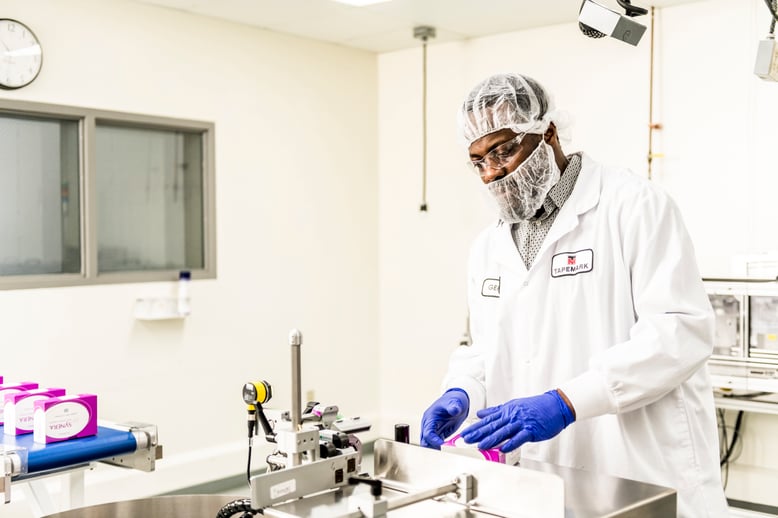
We are able to guide products through the necessary steps to develop, test, validate, and approve a process for serializing a product in a reliable and repeatable manner. We have full vision inspection on the lot code information and bar code data. Each product is scanned and verified upon aggregation to ensure accuracy.
What follows is a typical step-by-step serialization process at Tapemark:
- Configure connection from line-level machinery through L4 provider database to customer and final product shipping location
- Perform batches in the test environment to ensure serial numbers and batch reports transfer correctly
- Validate all serialization and aggregation of test batches and the communication through all the systems
- Begin commercial production with saleable product
To learn more about the different levels of pharmaceutical serialization, watch this video featuring Tapemark’s Lauren Hillman:
To review, our pharmaceutical serialization capabilities cover:
- Pouches
- Cartons
- Shippers
- Pallets
In addition, Tapemark has the capabilities to do partial cases, pallets, and bundles.
Serialization Labels & Labeling Equipment
At Tapemark, our serialization capabilities are made possible by Optel, our main piece of serialization equipment. It shows progress on all of our reports during jobs, enabling us to keep track of our samples and everything we’ve taken out of the job. Watch this video with Lauren Hillman to get an up close look at Optel:
In every project, we adhere to the most up-to-date serialization and cartoning regulations.
We are confident in saying our serialization process is robust and rigorously tested.
4. Pharmaceutical Shipping
/tapemark-shipment.jpg?width=300&name=tapemark-shipment.jpg) As part of our CDMO services, we offer full shipping customization. It’s about developing a process to match each client's exact needs. Undoubtedly, our primary goal in shipping is every client receives their product on time and in excellent condition. Pharmaceutical shipping is an opportunity to show intention and effort to every client, and client satisfaction means a great deal at Tapemark.
As part of our CDMO services, we offer full shipping customization. It’s about developing a process to match each client's exact needs. Undoubtedly, our primary goal in shipping is every client receives their product on time and in excellent condition. Pharmaceutical shipping is an opportunity to show intention and effort to every client, and client satisfaction means a great deal at Tapemark.
A great benefit of our shipping process is our ability to completely customize the experience for our clients. We focus on listening to every single client request and developing our shipping process based on those requests. We align everything to best suit our clients and their product.
Are you interested in partnering with Tapemark on an upcoming project? Let’s talk.
